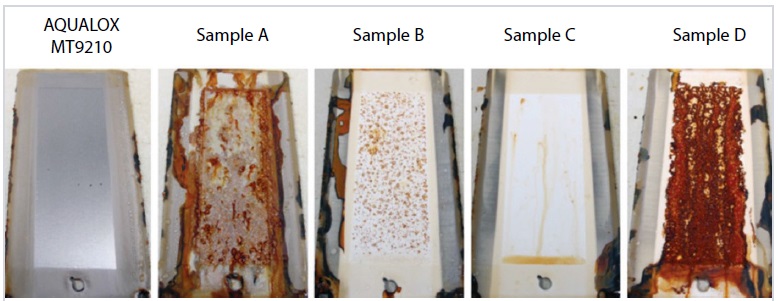The Lubrizol Corporation
High Performance Acrylic Chemistry for Metal Protection
By Ben Faber, Metalworking Product Manager, The Lubrizol Corporation | TLT CMF Plus November 2014
Rust preventive fluids as we know them have been in use since World War II. Since then, advancements have been made but the general recipe still holds: petroleum wax + metal sulfonates + solvent = traditional rust preventive. As industrialized nations begin to institute policies to protect the environment, tough restrictions have been implemented to reduce the amount of volatile organic compounds (VOCs) released into the air. Increased scrutiny on VOCs places greater challenges on the suppliers of rust preventive coatings because solvents are heavily depended on for proper film formation.
VOCs are a direct contributor to air pollution because they are a major component of smog (
1). Smog is low altitude ozone, and has many negative health effects. The volatile hydrocarbons released while a coating is drying are considered VOCs, and are a major target for reducing air pollution by regulatory bodies. For example, VOC limits for architectural coatings have been in place statewide in the US since 1998 (
2), and in Canada since 2008. Furthermore, certain regional environmental agencies have enacted tougher restrictions, including the California Air Resource Board (CARB) and the Ozone Transport Committee (OTC) of the Northeastern states (
3).
It is expected that tougher VOC legislation will be extended beyond paints and will begin to impact metalworking. In fact, the South Coast Air Quality Management District (SCAQMD) already did that when they implemented Rule 1144 for the Los Angeles, California area (
4). With California setting an example, it is likely that more agencies will follow suit and continue to further restrict VOCs. Any restriction would have a major impact on rust preventives, as many use hydrocarbon solvents as a carrier. Solvents are desired by end-users because they speed film formation and can enhance water separation, both of which can improve productivity.
If a switch to other carriers besides solvent must be made for compliance, it makes sense to look to the paint and coatings industry for inspiration on meeting the requirements. The paint and coatings industry has employed water-based polymer emulsions for decades as alternatives to oil-or solvent-based coatings. In addition to providing lower VOC, water-based polymer films offer other advantages. In most regions water is plentiful and cost effective, so there can be a cost advantage to switching from solvent to water. Also, depending on the polymer selected, the dry film can exhibit excellent adhesion, hardness, and toughness. The barrier and physical properties of polymer films are superior in many ways to the oil- and wax-based rust preventives of today. For the formulator, polymer emulsions typically come in an easy-to-use liquid form, and need no melting or heavy processing prior to use.
Introducing AQUALOX™ MT9210
In order to help coatings manufacturers prepare for the VOC regulations in the pipeline, and to offer a heavy-duty water-based product that compares in performance to the best solvent-based rust preventives today, Lubrizol has developed AQUALOX™ MT9210. AQUALOX MT9210 is a water-based acrylic emulsion formulation containing corrosion inhibitor, cosolvents, preservative, and defoamer. The product contains no pigments and forms a clear-coat rust preventing film when applied to a metal substrate. As-is, AQUALOX MT9210 is formulated with the minimum ingredients necessary to form a strong, cohesive film that protects metals from rust. When further formulated with high performance additives, AQUALOX MT9210 can be customized to provide additional performance features in order to fit new or existing applications.
AQUALOX MT9210 is a milky emulsion and has the appearance, consistency, and smell of a standard water-based acrylic paint. It is intended to be applied to clean, oil-free metal, and has proven to have excellent adhesion to steel, galvanized steel, phosphated steel, aluminum, copper, and even more substrates. AQUALOX MT9210 is a patent-pending coating that will keep the metal surface free of flash rust while the film dries.
AQUALOX MT9210 is best used as a heavy-duty outdoor coating for steel structures, parts, and equipment. Automotive parts, construction scaffolding, coastal bridge maintenance, and offshore oil rigs are just some of the applications where it can be used. When applied at a dry film thickness of 50 microns or higher, AQUALOX MT9210 can withstand long-term outdoor exposure and hold up to rain, snow, salt, and ultraviolet light.
Acrylic Coating Comparison
To test the corrosion performance of AQUALOX MT9210, Lubrizol purchased four commercially available direct-to-metal (DTM) 1K acrylic emulsions, all of which dry through coalescence just like AQUALOX MT9210. All of the commercially available acrylics tested claimed outdoor protection and corrosion resistance as key performance attributes. All of the products had similar usage instructions, and could be used by themselves as a single coat without the need for primers or topcoats.
In order to test all of the products equally, films were cast on AISI 1010 carbon steel test panels at 50 microns (+/- 10%) dry film thickness. All films were cast as one single coat using a square, multi-pass draw down tool at sufficient wet film thickness to yield 50 microns dry film thickness. The uncoated edges of each steel panel were protected with a heavy duty paraffin wax to protect the uncoated portions. All coated panels were allowed to dry in an ambient laboratory environment (70°F, 25% relative humidity) for seven days prior to any testing. This drying time was selected to eliminate variations in dry time due to seasonal variations in the climate.
ASTM B117 Salt Spray
One of the most popular techniques for measuring the corrosion protection of a coating is using the ASTM B117 salt spray test. This is an accelerated exposure test that uses an aqueous 5% sodium chloride solution to speed up the corrosion process. During this evaluation, the time to failure was measured as the hours the coating could withstand the salt spray until there was 5% corrosion visually apparent.
AQUALOX MT9210 far exceeds the performance of the other acrylic coatings in the salt spray cabinet, lasting up to 1,344 hours (28 days). As shown in
Figure 1, some of the other coatings tested show considerable corrosion after only 336 hours (14 days).
Figure 2 shows that AQUALOX MT9210 provides extreme-duty corrosion protection by outperforming the other coatings after 1,344 hours of salt spray exposure.
 Figure 1. Photos of the acrylic coatings tested in the ASTM B117 salt spray test after 336 hours of exposure.
Figure 1. Photos of the acrylic coatings tested in the ASTM B117 salt spray test after 336 hours of exposure.
 Figure 2. Photos of the acrylic coatings tested in the ASTM B117 salt spray test after 1,344 hours of exposure.
ASTM D1014 Outdoor Exposure
Figure 2. Photos of the acrylic coatings tested in the ASTM B117 salt spray test after 1,344 hours of exposure.
ASTM D1014 Outdoor Exposure
While the salt spray test is useful for testing coatings in extreme environments, its usefulness is limited as many coatings will never be exposed to salt during their lifetime. The most applicable test to monitor how a coating will do in a real-world environment is to actually place the coating in that exact real-world environment. ASTM D1014 outlines how to test the performance of a coating using an outdoor exposure test method.
AQUALOX MT9210 was compared to the same four commercially available acrylic emulsions using the outdoor exposure test method, and again it outperformed the competition. Steel test coupons were evaluated as part of an outdoor exposure study in Cleveland, OH for one year (Aug. 2013 to Aug. 2014).
Figure 3 shows the steel surface after the films have been removed, and the steel underneath AQUALOX MT9210 is still bright and corrosion free after one year of outdoor exposure.
 Figure 3. Photos of the acrylic coatings after one year of outdoor exposure according to ASTM D1014. These photos are after the films have been removed with the aid of an acrylic paint stripping gel. This was done to inspect for corrosion under the film.
Figure 3. Photos of the acrylic coatings after one year of outdoor exposure according to ASTM D1014. These photos are after the films have been removed with the aid of an acrylic paint stripping gel. This was done to inspect for corrosion under the film.
Some of the other coatings tested began to break down after one month of outdoor exposure. One coating in particular, Sample A, was damaged by the ultraviolet light and quickly stained, cracked, and allowed corrosion to begin. Samples B and D took longer to show signs of corrosion, but both showed heavy pinhole corrosion after three months. The best performing competitive product was Sample C, which was still corrosion free as well after one year of outdoor exposure. This outdoor exposure test will continue for an extended period of time.
Long-Lasting Performance
AQUALOX MT9210 was developed with corrosion protection in mind, and the product was carefully balanced to provide premium performance in salty, humid, hot, and acidic environments. AQUALOX MT9210 is an exciting addition to Lubrizol’s rust preventive product portfolio. AQUALOX MT9210 al lows formulators to utilize the corrosion benefits of a traditional heavy-duty rust preventive in a water-based acrylic package. The end-user will enjoy a hard, dry-to-touch metal coating that provides heavy-duty corrosion protection unmatched by the industry. Both the formulator and the end-user can rest assured that AQUALOX MT9210 will allow them to meet the most stringent of VOC regulations while still providing long-lasting protection.
References
1.
United States Environmental Protection Agency, (2012, November 1). Basic Information – Ground Level Ozone. Retrieved from
here.
2.
United States Environmental Protection Agency, (1998, September 11). National Volatile Organic Compound Emission Standards for Architectural Coatings. Retrieved from
here.
3.
Environment Canada, (2013, January 21). Revisions to the Proposed VOC Concentration Limits for Certain Products Regulations. Retrieved from
here.
4.
South Coast Air Quality Management District, (2010, July 9). Rule 1144 – Metalworking Fluids and Direct-Contact Lubricants. Retrieved from
here.